Michael Michael Maristany, Maristany, MD MD Prepared Prepared by by
27 Slides9.88 MB

Michael Michael Maristany, Maristany, MD MD Prepared Prepared by by Carlos Carlos R. R. Giménez, Giménez, MD, MD, FACP FACP Professor Professor of of Radiology Radiology Former Former Director Director MRI MRI Body Body Division Division and and MSK MSK Section Section LOUISIANA LOUISIANA STATE STATE UNIVERSITY UNIVERSITY MEDICAL MEDICAL CENTER CENTER School School of of Medicine Medicine in in New New Orleans Orleans

DIAGNOSIS & TREATMENT CLINICAL HISTORY DIAGNOSIS BONE LESION RADIOLOGY RADIOLOGY PATHOLOGY PATHOLOGY

Diagnosticmodalities modalities Diagnostic

DIAGNOSTIC IMAGING PLAIN RADIOGRAPH NUCLEAR MEDICINE SKELETAL CT MRI ANGIOGRAPHY BIOPSY

Diagnostic algorithm Radiographs of the symtomatic area diagnosis Yes stop MRI/CT CHARACTERIZATION no CT for assessing matrix Composition MRI for assessing bone & soft tissue Component Nuclear medicine for Assessing asymptomatic Multiplicity or activity

CONVENTIONAL CONVENTIONAL Rx Rx IT REMAINS AS THE MOST RELIABLE IN THE HISTOLOGIC NATURE OF A SPECIFIC LESION DETECTION LOCALIZATION CHARACTERIZATION

Tid Tid bits bits It is always a good idea to start with a radiograph of the area in question. Proceed with MRI if you are concern with ligaments or soft tissue problems, occult fracture or characterization A CT if you are more concern with bony problems Sometimes you need both.

Case 1 28 yo male complains of arm pain

SUPRASPINATUS Hx: unable to lift arm. Shoulder X-Ray (-)

RUPTURE ACL PARTIAL PCL

RETINACULUM RETINACULUM RUPTURE RUPTURE ACL ACL RUPTURE RUPTURE MCL RUPTURE PCL Fx

Ligament Ligament injuries injuries CT is more optimal than MRI True or False

For the evaluation of Disc disease, ligamentous or spinal cord injury in trauma MRI is preferred For the evaluation of vertebral fractures in spine trauma CT is preferred. Point: Both are use in evaluation of the spine in trauma.!

UNILATERAL FACET LOCK

BILATERAL FACET LOCK

Fx POSTERIOR POSTERIOR ARCH ARCH AXIS AXIS -- ANTERIOR ANTERIOR SUBLUXATION SUBLUXATION AXIS AXIS Fx

Indirect Signs of Thoracic Spine Injury Paravertebral hematoma Mediastinal widening Pleural fluid (hemothorax) Sternal fracture Rib fractures & costovertebral dislocations The double spinous process sign

C # 8005 BURST BURST FRACTURE FRACTURE

Medullary Medullary compression compression by by disc disc degeneration degeneration

Extruded disc 2 5

L 5 - S 1 HERNIA












